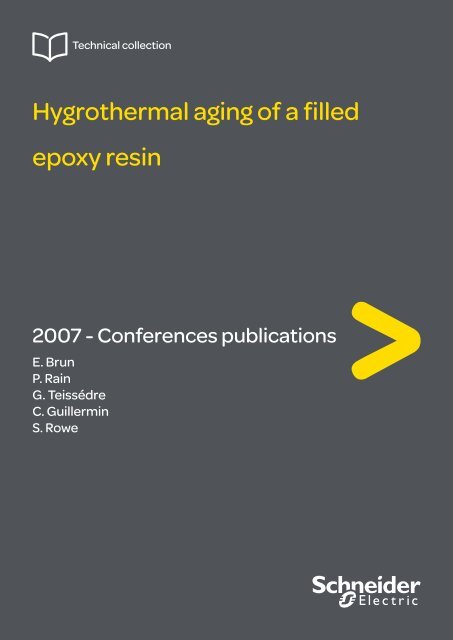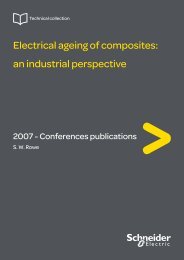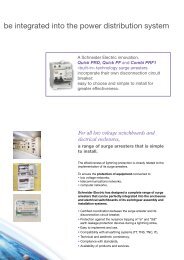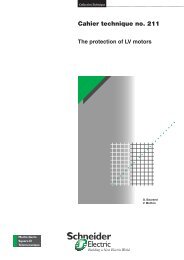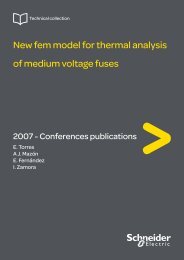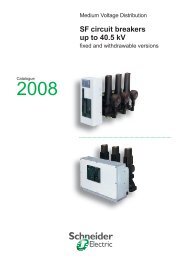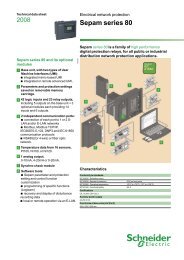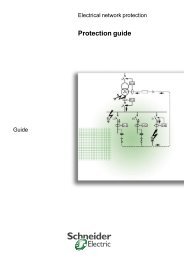Hygrothermal aging of a filled epoxy resin - Schneider Electric
Hygrothermal aging of a filled epoxy resin - Schneider Electric
Hygrothermal aging of a filled epoxy resin - Schneider Electric
You also want an ePaper? Increase the reach of your titles
YUMPU automatically turns print PDFs into web optimized ePapers that Google loves.
Technical collection<br />
<strong>Hygrothermal</strong> <strong>aging</strong> <strong>of</strong> a <strong>filled</strong><br />
<strong>epoxy</strong> <strong>resin</strong><br />
2007 - Conferences publications<br />
E. Brun<br />
P. Rain<br />
G. Teissédre<br />
C. Guillermin<br />
S. Rowe
<strong>Schneider</strong> <strong>Electric</strong> 2007 - Conferences publications<br />
2007 InternationalConferenceon Solid Dielectrics, Winchester, UK, July 8-13, 2007<br />
<strong>Hygrothermal</strong> <strong>aging</strong> <strong>of</strong> a <strong>filled</strong> <strong>epoxy</strong> <strong>resin</strong>.<br />
E. Brun 2 , P. Rain 1* , G. Teissèdre 1 , C. Guillermin 2 , S. Rowe 2<br />
1 Grenoble <strong>Electric</strong>al Engineering Lab (G2Elab), CNRS- Université de Grenoble, Grenoble - France<br />
2 <strong>Schneider</strong> <strong>Electric</strong>, Grenoble, France<br />
* E-mail : pascal.rain@grenoble.cnrs.fr<br />
Abstract: The hygrothermal conditioning <strong>of</strong> an <strong>epoxy</strong><br />
<strong>resin</strong> at 80°C under 80% RH has been followed by<br />
weight measurements, thermogravimetric analysis<br />
(TGA) and dynamical mechanical analysis (DMA). The<br />
samples are either <strong>filled</strong> with 60% by weight <strong>of</strong> silica<br />
flour or are not <strong>filled</strong>. Above an apparent saturation<br />
value <strong>of</strong> about 1.5% reached within a few days, a slight<br />
but significant mass uptake was observed in the <strong>filled</strong><br />
<strong>resin</strong>, especially after 50 days. The TGA showed an<br />
evolution <strong>of</strong> the <strong>filled</strong> samples with conditioning after<br />
50 days as well, which was not observed on un<strong>filled</strong><br />
samples. For the <strong>filled</strong> samples, the elastic modulus in<br />
the rubbery state decreased with conditioning. These<br />
evolutions have been attributed to the formation <strong>of</strong> a<br />
degraded inter-phase region due to hydrolysis occurring<br />
after the debonding <strong>of</strong> the filler-matrix interface caused<br />
by the absorbed water.<br />
INTRODUCTION<br />
Filled <strong>epoxy</strong> <strong>resin</strong> has been used for many years in<br />
electrical engineering. The material is submitted to<br />
thermal and electrical stress and is in contact with the<br />
environment. The mechanisms leading to the occurrence<br />
<strong>of</strong> electrical breakdown are still not properly<br />
understood. A great variety <strong>of</strong> electrical, thermal,<br />
mechanical, chemical phenomena may be involved in<br />
the ageing <strong>of</strong> these polymeric insulations. Since the<br />
material may be exposed to a humid environment, the<br />
present work focuses on the specific influence <strong>of</strong> water<br />
on the material and its effects on the electrical rigidity.<br />
From an electrical point <strong>of</strong> view, the impact <strong>of</strong> water on<br />
the dielectric behaviour <strong>of</strong> <strong>filled</strong> <strong>epoxy</strong> <strong>resin</strong>s has been<br />
extensively described. As concerns the electrical<br />
rigidity, the breakdown voltages <strong>of</strong> wet materials may<br />
fall by a factor <strong>of</strong> 5 to 10 in comparison with a dry<br />
material [1-3]. In composites, the interfaces between the<br />
matrix and the mineral fillers are known to be zones <strong>of</strong><br />
weakness [4-6]. The shape <strong>of</strong> the fillers may also<br />
influence the breakdown voltage [7]. Furthermore, the<br />
deleterious influence <strong>of</strong> water on <strong>epoxy</strong> <strong>resin</strong> is well<br />
known [8]. The main mechanisms leading to physical<br />
and chemical degradation <strong>of</strong> <strong>epoxy</strong> <strong>resin</strong> have been<br />
illustrated or at least foreseen [9]. With the use <strong>of</strong> a<br />
FTIR spectrometer, water layers <strong>of</strong> a few hundred nm<br />
have been measured at an <strong>epoxy</strong>/glass interface [10].<br />
This order <strong>of</strong> magnitude is in accordance with the MEB<br />
observations reported in [3]. Water may accumulate at<br />
the interfaces and lead to a filler/matrix debonding,<br />
which may be followed by mechanical cracks<br />
propagating in the bulk material [11].<br />
For a better understanding <strong>of</strong> the overall mechanisms,<br />
the impact <strong>of</strong> the hygrothermal conditioning on the<br />
physical properties have thus been carried out first.<br />
<strong>Electric</strong>al characterisations will ensue. In the following,<br />
mass uptakes, thermogravimetric analyses and dynamic<br />
mechanical analyses are reported.<br />
EXPERIMENTAL PART<br />
Materials, Sampling and Conditioning<br />
The material used is a DGEBA based <strong>epoxy</strong> <strong>resin</strong> <strong>filled</strong><br />
or not with silica flour and cured with an anhydrid acid.<br />
The filler content is 60% by weight. The fillers’ sizes<br />
range between a few 0.1 μm and 200 μm.<br />
The components were mixed, cast in a mould then<br />
maintained at 100°C during one hour. After crosslinking,<br />
samples were demoulded and then cured at<br />
130°C during 16 hours. The sheets are 0.5 mm thick.<br />
Glass transition temperatures <strong>of</strong> the <strong>filled</strong> and un<strong>filled</strong><br />
samples are 72°C and 70°C respectively.<br />
Samples are cleaned with alcohol and dried in an oven<br />
at 50°C for 24 hours. After this preparation, their initial<br />
mass was measured. The samples were then conditioned<br />
in a climatic chamber at 80°C under 80%RH.<br />
Characterisations<br />
Moisture uptake measurements: Samples were<br />
periodically withdrawn from the climatic chamber.<br />
Before mass measurements were made, the temperature<br />
and hygrometry <strong>of</strong> the samples were stabilized. For this<br />
purpose, they were laid in a small quantity <strong>of</strong> water<br />
initially at 80°C. After 15 minutes, both water and<br />
sample were at ambient temperature. Samples were then<br />
dried with a suitable paper. The mass uptake was<br />
measured with an electronic Ohauss balance Explorer.<br />
Thermogravimetric analysis (TGA): The thermal<br />
stability <strong>of</strong> the materials has been evaluated throughout<br />
conditioning by TGA with a TA instruments® 2050.<br />
The mass loss <strong>of</strong> the samples was measured during a<br />
temperature rise <strong>of</strong> 3°C/min between -40°C and 850°C.<br />
Experiments were carried under nitrogen to avoid added<br />
oxidation. A gas flow <strong>of</strong> 45 mL/min inside the oven<br />
allowed the extraction <strong>of</strong> the thermolysis by-products.<br />
The relative mass loss <strong>of</strong> samples with initial mass <strong>of</strong> 10<br />
1-4244-0750-8/07/$20.00©2007 IEEE.<br />
239
<strong>Schneider</strong> <strong>Electric</strong> 2007 - Conferences publications<br />
to 20 mg is reported hereafter.<br />
Dynamic Mechanical Analysis (DMA): The evolution<br />
<strong>of</strong> mechanical properties and thermal transitions during<br />
conditioning were measured by DMA with a TA<br />
instruments® 2980 using the 3-point bending mode.<br />
Taking into account the elastic domain <strong>of</strong> the material,<br />
the measurement conditions were the following: a<br />
dynamic magnitude <strong>of</strong> 50µm and a static force <strong>of</strong> 140%<br />
<strong>of</strong> the dynamic force. The samples were rectangular in<br />
shape 40×10×0.5mm 3 . The frequency was 1Hz and the<br />
temperature rise was 3°C/min from -40°C to 140°C.<br />
RESULTS AND DISCUSSION<br />
Moisture uptake results<br />
Three different samples, either <strong>filled</strong> or not <strong>filled</strong>, were<br />
measured for each conditioning duration. Mean values<br />
and standard deviations are reported in Figure 1. For a<br />
better comparison <strong>of</strong> the two materials, mass variations<br />
<strong>of</strong> the <strong>filled</strong> samples were calculated taking into account<br />
the initial mass <strong>of</strong> un<strong>filled</strong> <strong>resin</strong>, evaluated by the mean<br />
filling content <strong>of</strong> 60%.<br />
Water saturation <strong>of</strong> not <strong>filled</strong> samples is observed after<br />
about 5 days. The water uptake was then <strong>of</strong> 1.5%. The<br />
mass uptake <strong>of</strong> <strong>filled</strong> samples is lower at the beginning<br />
than the one <strong>of</strong> un<strong>filled</strong> ones: the kinetics <strong>of</strong> water<br />
absorption is slower. The water diffusion is impeded by<br />
the silica grains, which slow down its propagation<br />
throughout the whole material. After 5 days<br />
conditioning, the mass variation was close to the one <strong>of</strong><br />
un<strong>filled</strong> samples but measurements tend to indicate that<br />
the mass uptake continues to progress after the quasi–<br />
saturation has been reached. This specific behaviour <strong>of</strong><br />
<strong>filled</strong> samples has already been reported in [12].<br />
Furthermore, a slope increasing after about 50 days has<br />
been observed in a similar way to that shown in [13].<br />
These measurements will be completed to confirm this<br />
tendency. This difference observed between the two<br />
materials can be attributed to phenomena taking place at<br />
the <strong>epoxy</strong>/silica interfaces. The following mechanism<br />
can be proposed. Firstly, water molecules break the<br />
physical bounds between the silica grains and the <strong>resin</strong><br />
and form H-bounds with the polymer. Then, some water<br />
mass uptake (%)<br />
2<br />
1.8<br />
1.6<br />
1.4<br />
1.2<br />
1<br />
0.8<br />
0.6<br />
0.4<br />
0.2<br />
0<br />
Un<strong>filled</strong> samples<br />
Filled samples<br />
0 20 40 60 80<br />
Conditioning time (days)<br />
Figure 1: Weight gain in un<strong>filled</strong> () and <strong>filled</strong> ()<br />
samples as a function <strong>of</strong> conditioning time.<br />
accumulates between the two phases, part <strong>of</strong> which<br />
possibly reacts with the <strong>resin</strong>.<br />
TGA results<br />
Thermogravimetric analysis was carried out for <strong>filled</strong><br />
and not <strong>filled</strong> samples after until 70 days <strong>of</strong><br />
conditioning. The thermal behaviour <strong>of</strong> unaged sample<br />
are mentioned as “reference” in the figures. The dots on<br />
the graphics are not measurements points but are added<br />
to improve visualisation <strong>of</strong> the data.<br />
The thermograms are displayed in Figure 2 for un<strong>filled</strong><br />
samples. The derivatives <strong>of</strong> the mass loss curves are<br />
also displayed to highlight the differences between the<br />
samples. A detail <strong>of</strong> the curves between 50°C and<br />
200°C is enlarged. This shows a significant decreasing<br />
<strong>of</strong> the mass between 50°C and 120°C in aged samples,<br />
which is not observed in reference samples. This mass<br />
loss is slightly lower than the water uptake measured by<br />
gravimetry. It corresponds to the evaporation <strong>of</strong><br />
absorbed water. Xu et al [13] observed an initial, weak,<br />
peak <strong>of</strong> the derivative weight in the same temperature<br />
range that they attributed to the evaporation <strong>of</strong> water<br />
contained only in the free volumes. They considered<br />
that the bound water was released at 200-300°C where<br />
they observe a slight difference between as-cured and<br />
aged samples. Our results do not confirm this point. The<br />
main mass loss occurred between 300 and 450°C. For<br />
all aged un<strong>filled</strong> samples investigated so far, the<br />
derivative weights display a maximum at about 398°C<br />
and a shoulder (maximum <strong>of</strong> the second derivative) at<br />
364°C. This corresponds to <strong>resin</strong> decomposition. At<br />
800°C, a residual mass <strong>of</strong> about 6% was measured<br />
which was not observed in similar experiment under<br />
oxygen flow. MEB analysis showed the presence <strong>of</strong><br />
carbon with low quantities <strong>of</strong> oxygen. MEB photos<br />
showed blackish sheets. This residue was then mainly<br />
composed <strong>of</strong> carbon graphite.<br />
For <strong>filled</strong> samples, residual masses were scattered and<br />
not correlated with the duration <strong>of</strong> conditionning. The<br />
mean value was 64%. Taking into account the residual<br />
Figure 2: Weight loss during a TGA dynamic test for<br />
un<strong>filled</strong> samples before (•) and after conditioning at<br />
80°C and 80%HR during 5 (+), 14 () and 50 () days.<br />
240
<strong>Schneider</strong> <strong>Electric</strong> 2007 - Conferences publications<br />
mass <strong>of</strong> 6% measured for the un<strong>filled</strong> samples, this<br />
value leads to a filler content <strong>of</strong> 58% which corresponds<br />
well with the “rated” filler content <strong>of</strong> 60%. To simplify<br />
the comparisons, the variations <strong>of</strong> the residual masses<br />
were neutralized in the results displayed in Figure 3.<br />
This shows the relative mass losses between the initial<br />
mass values <strong>of</strong> the samples and the residual masses.<br />
A mass loss between 50°C and 200°C can be observed,<br />
as in un<strong>filled</strong> samples. In these cases, the variations<br />
correspond well with the water uptake measured before.<br />
The <strong>resin</strong> decomposition can be observed in the same<br />
temperature range as above. As shown in the zoom in<br />
Figure 3, decomposition started at lower temperatures<br />
for longer conditioning periods. This is clear if we<br />
compare the curves for 50 and 70 days, which fit the<br />
curve <strong>of</strong> 14 days until about 200°C and decrease faster<br />
between 200°C and 300°C. This indicates an evolution<br />
<strong>of</strong> the material produced by the hygrothermal<br />
conditioning after about 50 days. Since this effect was<br />
not encountered in samples without fillers, the<br />
<strong>epoxy</strong>/silica interface regions are necessarily involved.<br />
We have already mentioned that the mass measurements<br />
suggest an accumulation <strong>of</strong> matter close to these<br />
interfaces. We may consider that this evolution is due to<br />
an hydrolysis <strong>of</strong> the filler/matrix interface regions which<br />
creates a degraded inter-phase region. Since the filler<br />
content is large, this degraded region may also fill the<br />
whole gap between neighbouring fillers and constitute<br />
“weak” path between them. This hydrolysis occuring<br />
after about 50 days is probably correlated with the<br />
increase <strong>of</strong> the mass uptake observed at the same time.<br />
The possible explanation <strong>of</strong> this is as follows: free space<br />
is created by the hydrolytic reactions consisting mainly<br />
in the attack <strong>of</strong> the ester linkages and creation <strong>of</strong> acid<br />
groups [4]. This allows extra water molecules to<br />
accumulate between the filler and the degraded region.<br />
However, the extra quantity <strong>of</strong> water involved in this<br />
mechanism would be low in comparison with the total<br />
quantity <strong>of</strong> absorbed water, which was almost entirely<br />
lost between 50°C and 150°C. Further experiments are<br />
under way to confirm this hypothesis.<br />
DMA results<br />
The dynamic mechanical analysis was carried out on<br />
four <strong>filled</strong> and four un<strong>filled</strong> samples after 0, 5, 14 and<br />
50 days <strong>of</strong> conditioning. The evolution <strong>of</strong> the elastic<br />
moduli E’ is displayed in Figure 4a. The magnitudes for<br />
the <strong>filled</strong> samples were about three times larger in the<br />
glassy state and five times larger in the rubbery state.<br />
The elastic modulus decreased during conditioning,<br />
especially in the glassy state. In practice, water<br />
molecules break the hydrogen bonds established inside<br />
the network. The bound water increases also the<br />
mobility <strong>of</strong> the polymer chains and causes a decrease <strong>of</strong><br />
the elastic modulus. This is the well-known waterinduced<br />
plasticization effect.<br />
In the rubbery state, we would expect the effect to be<br />
less marked since the chains are already mobile. Thus in<br />
this case, the modulus E’ depends theoretically on the<br />
density <strong>of</strong> cross-links in the <strong>epoxy</strong> network [14].<br />
Nevertheless, the conditioning induced a decrease <strong>of</strong> the<br />
elastic moduli E’ for the <strong>filled</strong> samples. For un<strong>filled</strong><br />
samples, the measurements were conducted at the lower<br />
limit <strong>of</strong> sensitivity <strong>of</strong> the DMA instrument. Such a<br />
decrease <strong>of</strong> the rubbery modulus has already been<br />
observed in [15]. It is not due to the plasticization but<br />
may be attributed to a degradation <strong>of</strong> the polymer,<br />
which probably results from hydrolysis <strong>of</strong> the <strong>resin</strong>.<br />
(a)<br />
M(Minitial-Mfinal)%<br />
100<br />
90<br />
80<br />
70<br />
60<br />
50<br />
40<br />
30<br />
20<br />
10<br />
0<br />
REF<br />
5 days<br />
14 days<br />
50 days<br />
70 days<br />
REF<br />
5 days<br />
14 days<br />
50 days<br />
70 days<br />
0 100 200 300 400 500 600<br />
T(°C)<br />
Figure 3: Weight loss during a TGA dynamic test for<br />
<strong>filled</strong> samples before (•) and after conditioning at 80°C<br />
and 80%HR during 5 (+), 14 (), 50 () and 70 () days<br />
with a zoom in the temperature range 0-350°C between<br />
92 and 100%.<br />
(b)<br />
Figure 4: Elastic modulus E’ (a) and loss modulus E’’<br />
(b) vs temperature <strong>of</strong> un<strong>filled</strong> (---) samples and <strong>filled</strong><br />
( ___ ) samples before (•) and after conditioning at 80°C,<br />
80%HR during 5(+), 14() and 50 () days.<br />
241
<strong>Schneider</strong> <strong>Electric</strong> 2007 - Conferences publications<br />
The glass transition temperatures have been taken at the<br />
maxima <strong>of</strong> the curves <strong>of</strong> loss moduli E’’ (Figure 4b).<br />
For the reference samples, the Tg were 70°C and 72°C<br />
respectively for the un<strong>filled</strong> and <strong>filled</strong> samples. These<br />
maxima shifted towards the low temperatures during<br />
conditioning, thus highlighting water-induced<br />
plasticization. This decrease occurred mainly within the<br />
first days <strong>of</strong> conditioning and is more important in the<br />
un<strong>filled</strong> samples. After a 50 days conditioning, the shift<br />
<strong>of</strong> the Tg values were <strong>of</strong> 14K and 11K for the un<strong>filled</strong><br />
and <strong>filled</strong> samples respectively. Similar evolutions have<br />
been already mentioned [16]. A secondary peak, which<br />
would have indicated the heterogeneity <strong>of</strong> the material<br />
[6, 12, 17], was not visible here.<br />
CONCLUSION<br />
Evidence <strong>of</strong> <strong>aging</strong> <strong>of</strong> <strong>filled</strong> <strong>epoxy</strong> <strong>resin</strong> conditionned at<br />
80°C and 80%RH were provided by weight<br />
measurements, thermogravimetric analysis (TGA) and<br />
dynamical mechanical analysis (DMA).<br />
Above an apparent saturation value <strong>of</strong> about 1.5%<br />
reached within a few days, a slight but significant mass<br />
uptake was observed in the <strong>filled</strong> <strong>resin</strong>. An<br />
accumulation <strong>of</strong> water at the <strong>epoxy</strong>/silica interface can<br />
be inferred, part <strong>of</strong> which may have chemically reacted<br />
with the polymer.<br />
Thermogravimetric analysis showed a degradation <strong>of</strong><br />
<strong>filled</strong> samples after a conditioning period longer than 50<br />
days, which does not occur in un<strong>filled</strong> samples.<br />
The decrease <strong>of</strong> the elastic modulus E’ and <strong>of</strong> the glass<br />
transition temperature Tg underlined the plasticization<br />
<strong>of</strong> the samples during conditioning. For the <strong>filled</strong><br />
samples, the elastic modulus in the rubbery state<br />
decreased with conditioning.<br />
These results suggest the creation <strong>of</strong> a degraded interphase<br />
region between the silica and the <strong>epoxy</strong> matrix<br />
due to the hydrolysis <strong>of</strong> the <strong>resin</strong>.<br />
REFERENCES<br />
[1] H.C. Kärner and M. Ieda, “Technical aspects <strong>of</strong><br />
interfacial phenomena in solid insulating”, Proc. <strong>of</strong><br />
the 3 rd IEEE Int. Conf. On Prop and Appl <strong>of</strong> Diel<br />
Mat, p. 592-597, 1991.<br />
[2] T. Kumazawa, M. Oishi and M. Todoki, “Highhumidity<br />
deterioration and internal structure change<br />
<strong>of</strong> <strong>epoxy</strong> <strong>resin</strong> for electrical insulation”, IEEE<br />
Transactions on dielectrics an <strong>Electric</strong>al<br />
Insulation, vol. 1, n°1, p. 133-138, 1994.<br />
[3] T. Kumazawa, M. Oishi, M. Todoki and T.<br />
Watanabe, “Physical and chemical structure change<br />
<strong>of</strong> <strong>filled</strong> <strong>epoxy</strong> due to water absorption”, 5 th IEEE<br />
int.Conf. on Prop and Appl <strong>of</strong> Diel Mat, p. 491-494,<br />
1997.<br />
[4] M.K. Antoon and J.L. Koenig, “Irreversible effects<br />
<strong>of</strong> moisture on the <strong>epoxy</strong> matrix in glass-reinforced<br />
composites”, J.Polym. Sci. Phy. Ed., vol. 19, p.<br />
197-212, 1981.<br />
[5] Janssen H., Seifert J.M. and Kärner H.C., Interfacial<br />
phenomena in comopsite high voltage insulation,<br />
IEEE Transactions on dielectrics an <strong>Electric</strong>al<br />
Insulation, vol. 6, 1999, p. 651-659.<br />
[6] D.H. Kaelble and P.J. Dynes, “<strong>Hygrothermal</strong> <strong>aging</strong><br />
<strong>of</strong> composite materials”, J. Adhesion, vol. 8, p. 195-<br />
212, 1977.<br />
[7] M. Ezoe, M. Nakanishi and J. ShouGou, “Effects <strong>of</strong><br />
water absorption on interfacial phenomena in HV<br />
insulating materials”, IEEE High Voltage<br />
Engineering Symposium, 1999, 4.244-4.247, 1999.<br />
[8] A.C. May, Epoxy <strong>resin</strong>s, New York, Dekker<br />
Edition, 1988.<br />
[9] J. Verdu, Action de l’eau sur les plastiques, Paris,<br />
Techniques de l’ingénieur, vol AM 3 165.<br />
[10] T. Nguyen, E. Byrd and D. Bentz, “In situ<br />
measurement <strong>of</strong> water at the organic<br />
coating/substrate interface”, Progress in organic<br />
coatings, vol. 27, p. 181-193, 1996.<br />
[11] K.A. Kasturiarachchi and G. Pritchard, Scanning<br />
electron microscopy <strong>of</strong> <strong>epoxy</strong>-glass exposed to<br />
humid condition, J. <strong>of</strong> Mat. SC., vol. 20, p. 2038-<br />
2044, 1985.<br />
[12] M.J. Adamson, “Thermal expansion and swelling<br />
<strong>of</strong> cured <strong>epoxy</strong> <strong>resin</strong> used in graphite/<strong>epoxy</strong><br />
composite materials”, J. Mater. Sci., vol. 15, p.<br />
1736-1745, 1980.<br />
[13] S. Xu and D.A. Dillard, “Environmental <strong>aging</strong><br />
effects on thermal and mechanical properties <strong>of</strong><br />
electrically conductive adhesives”, J. Adhesion, vol.<br />
79, p. 699-723, 2003.<br />
[14] T. Murayama and J.P. Bell, “Relation between the<br />
network structure and dynamic mechanical<br />
properties <strong>of</strong> a typical amine-cured <strong>epoxy</strong><br />
polymer”, J. Polym. Sci., vol. 8, p. 437-445, 1970.<br />
[15] K.I. Ivanova, R.A. Pethrick and S. Affrossman,<br />
“Investigation <strong>of</strong> hydrothermal <strong>aging</strong> <strong>of</strong> a <strong>filled</strong><br />
rubber toughened <strong>epoxy</strong> <strong>resin</strong> using dynamic<br />
mechanical thermal analysis and dielectric<br />
spectroscopy”, Polymer, vol. 41, p. 6787-6796,<br />
2000.<br />
[16] A. Apicella, L. Egiziano, L. Nicolais and V. Tucci,<br />
“Environmental degradation <strong>of</strong> the electrical and<br />
thermal properties <strong>of</strong> organic insulating materials”,<br />
J. Mater. Sci., vol. 23, p. 729-735, 1988.<br />
[17] L. Wang, K. Wang, L. Chen, C. He, L. Wang et al,<br />
“<strong>Hygrothermal</strong> effects on the thermomechanical<br />
properties <strong>of</strong> high performance <strong>epoxy</strong>/clay<br />
nanocomposites”, Polymer Engineering and<br />
Science, p. 215-221, 2006.<br />
242


